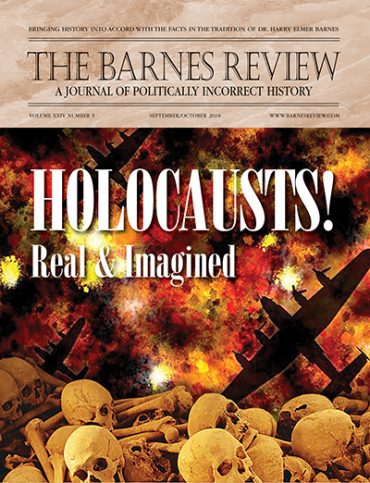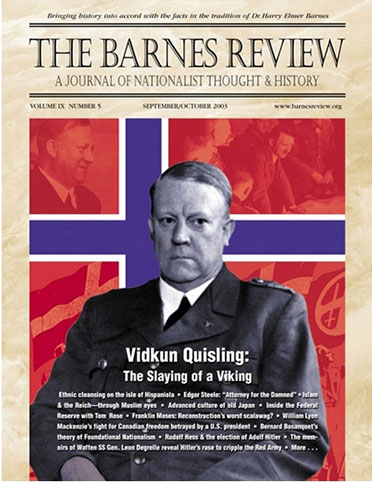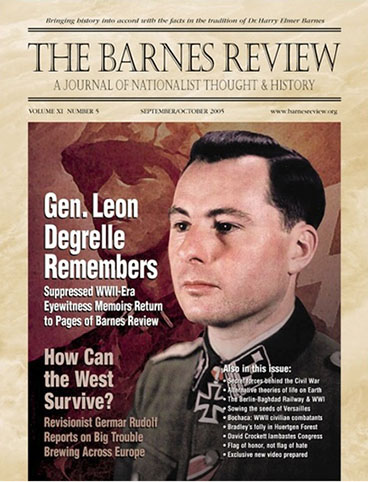Description
The Barnes Review
A JOURNAL OF POLITICALLY INCORRECT HISTORY
September/October 2018 ❖ VOLUME XXIV ❖ NUMBER 5
TABLE OF CONTENTS
THE REVIVAL OF THE HOUSE OF KIM
BY DR. EDWARD DEVRIES. Who is Kim Jong Un—the supreme leader of North Korea—and is he the murderous psychopath we are told by the Western media? If so, why do his people adore him?
AN AMERICAN INDIAN HOLOCAUST
BY HARALD HESSTVEDT SCHARNHORST. This group of Indians was within eyesight of the Canadian border and freedom. But their dream was not to be: The U.S. governmnt would not allow a single one of them to escape.
THE BOLSHEVIK HOLOCAUSTERS
BY MICHAEL WALSH. Was Bolshevism a Jewish phenomenon? Zionists vehemently deny it. But a close look at the rulers of the regime supports the idea that Red Russia was a “Jewish Reich.”
HITLER AND THE WWI HOLOCAUST
BY MARC ROLAND. What events forged Adolf Hitler? Were his experiences in the holocaust of World War I the defining moments of this man’s life?
HOLOCAUST ON THE EASTERN FRONT?
BY JOHN WEAR, J.D. At the end of WWII, it was alleged at the Einsatzgruppen Trial that German troops holocausted millions on the Eastern Front. Many were convicted—but on what evidence?
EXAMINING THE BABI YAR INCIDENT
BY JOHN WEAR, J.D. It was one of the worst mass murders in human history—40,000 innocent Jews killed and thrown into the Babi Yar ravine. But why do Revisionists claim it never happened?
THE HOLOCAUST OF TOKYO
BY THOMAS GOODRICH. Why did the Allies insist on incinerating hundreds of thousands of Japanese civilians in 67 cities across Nippon? Were they burnt offerings sacrificed on Uncle Sam’s altar?
TABOO: THE DRESDEN HOLOCAUST
BY LADY MICHELE RENOUF. After making some completely truthful comments at an outdoor gathering to commemorate Germans burnt alive in Dresden, Lady Michele Renouf was arrested. Why?
THE COSSACKS AVOID A HOLOCAUST
BY MICHAEL WALSH. After the czarists realized their battle to regain Russia from the Bolsheviks was a lost cause, the Cossack armies rushed to make their escape before being holocausted.
NORTHERN GREED AND ITS TRAIL OF TOTAL DESTRUCTION
BY CLINT LACY. War is a terrible thing—a tragedy to be avoided at all costs. We know this, yet again and again man is set at his brother’s throat. Who profits—and who gets holocausted?
THE HOLOCAUST OF THE SOUTH
BY REV. HERBERT L. BROWN. At the end of the Civil War, the civilians of the South were subjected to a “barbarian conquest”—holocausted by Northern generals.
THE MASS EXPULSION HOLOCAUST
BY REV. HERBERT L. BROWN. After WWII ended, an orgy of revenge began against the German people, the likes of which had not been seen before or since.
THE MK-ULTRA MIND HOLOCAUST
BY S.T. PATRICK. Considered a fantasy of conspiracy theorists, we now know that thousands of people had lives ruined by a CIA program.
A CULTURAL HOLOCAUST IN EUROPE
BY THE BARNES REVIEW STAFF. Is it a conspiracy—the cultural holocaust of white Europe? Here is a pictorial “travel guide” you might want to consult before traveling to Paris—or Europe in general.


